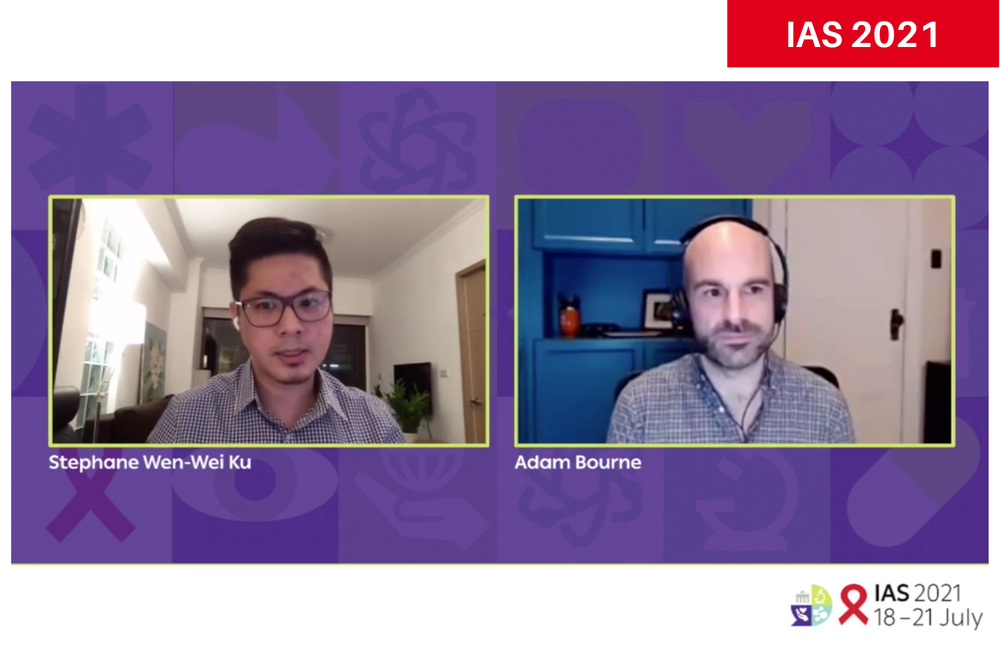
Sexualised drug use, or chemsex, is steeply on the rise among Thai men who have sex with men (MSM) and trans women living with HIV – with those reporting injecting methamphetamine use increasing by 16% from 2009 to 2019, Dr Camilla Muccini from the Institute of HIV Research and Innovation in Bangkok told the 11th International AIDS Society Conference on HIV Science (IAS 2021) last week. Chemsex was strongly associated with getting other sexually transmitted infections (STIs), including hepatitis C.
Speaking at a prime session on the topic, Dr Stephane Wen-Wei Ku, Director of the Infectious Disease Unit at Taipei City Hospital in Taiwan, stressed the need for integrated sexual health and substance use services. He also spoke about the importance of adopting a harm reduction approach regarding both substance use and HIV and other STI prevention.
Chemsex in Thailand
The use of methamphetamine has increased among young MSM in Bangkok and is associated with new HIV infections, sex work, group sex and the widespread use of hook-up apps.
The ongoing RV254/SEARCH010 study recruits MSM and trans women who are newly diagnosed with HIV (acute infection) since 2009. Previous findings indicated an epidemic of hepatitis C in this cohort, with factors such as methamphetamine use, group sex and a history of syphilis being significantly associated with new hepatitis C infections.
Participants completed questionnaires at baseline. In addition, between 2017 and 2019, they completed six-monthly questionnaires related to their substance use (including alcohol, poppers and medications such as Viagra) and chemsex behaviours, such as group sex. Hazardous alcohol intake was measured using the AUDIT-C, which combines self-report data on alcohol intake with data gathered by physician interview. There was regular screening for syphilis, chlamydia, gonorrhoea and hepatitis C antibodies.
A total of 604 participants were recruited between 2009 and 2019. The median age at baseline was 26. Most of the sample identified as male (98%) and was enrolled between 2009 and 2016 (467 participants). Nearly half of the sample was estimated to have had HIV for 25 days at the time they were enrolled into the study.
When comparing baseline reports from participants entering the study before or after 2017, those recruited more recently were significantly more likely to report taking any amphetamine-type stimulants (33% vs. 21%), including methamphetamine (30% vs 19%). They were also much more likely to inject methamphetamine (20% vs. 4%). Interestingly, alcohol use was reported by the 2017-2019 participants less frequently (54% vs. 92%).
When looking more closely at the regular questionnaires between 2017 and 2019, any recreational drug use increased from being reported by just over 20% of participants in 2017 to 35% in 2019. There was a significant increase in the numbers of participants reporting use of amphetamine-type stimulants, poppers, ecstasy and drugs used to get an erection over this period. Reports of hazardous alcohol consumption increased by 20% between 2017 and 2019.
Participants who used recreational drugs were approximately three times more likely to acquire hepatitis C or syphilis, and nearly eight times as likely to have gonorrhoea than those not reporting drug use. While recreational drug users were eight times more likely to engage in group sex, those reporting methamphetamine injection were 28 times more likely to engage in group sex and over four times more likely to be coinfected with hepatitis C.
“Substance use screening at diagnosis and at every routine visit should be integrated into routine clinical practice for MSM with HIV in Thailand,” Muccini concluded. “For those who screen positive, drug treatment and counselling for harm reduction could potentially mitigate the adverse clinical outcomes.”
A greater focus on integrated services and harm reduction is needed
Wen-Wei Ku described chemsex among MSM as a syndemic (the intersection between two or more epidemics, such as substance use and HIV) that requires immediate attention. Despite showing that sexualised drug use occurs among people of different genders and sexualities, he focused on the chemsex phenomenon among gay and bisexual men. Wen-Wei Ku pointed to data from Taiwan, Vietnam, Thailand, Malaysia, Singapore and Japan suggesting that chemsex is not restricted to the western countries where it is most often studied.
He pointed out some crucial issues facing practitioners who care for men who inject metamphetamine, including the lack of evidence-based interventions, a lack of skills related to working with MSM engaging in chemsex and the fact that there is no well-established effective replacement therapy available for methamphetamine, as there is for people with opioid-use disorders. There are also few international, multi-disciplinary platforms available for collaboration and advocacy.
Additionally, there is a great deal of stigma associated with drug use in general, injecting drug use specifically and HIV more broadly. This means that injecting substance users are highly stigmatised groups who may struggle to access HIV services. This is further compounded in countries where there are anti-LGBT laws and drug use is criminalised.
Both he and Muccini advocated for integrated sexual health and substance use services, as most individuals engaging in chemsex prefer to receive services from LGBT or sexual health organisations as opposed to in substance use or mental health settings. Additionally, he emphasised the need for harm reduction strategies. This includes support for PrEP use or HIV treatment adherence, regular screening for other STIs and culturally tailored clean needle exchange programmes.
“Chemsex, especially with the use of crystal methamphetamine, has emerged in a subgroup of gay and bisexual men globally and impacts the sexual and mental health of this population,” Wen-Wei Ku concluded. “Culturally-sensitive and evidence-based interventions integrated with HIV preventative strategies should be developed and implemented promptly.”
References
Muccini, C et al. Rising substance use linked to STI and HCV in Thai MSM after acute HIV infection. 11th IAS Conference on HIV Science, abstract OAB0102, 2021.
Wen-Wei Ku, S. Sexualised drug use and HIV infection. 11th IAS Conference on HIV Science, prime session PR07, 2021.
